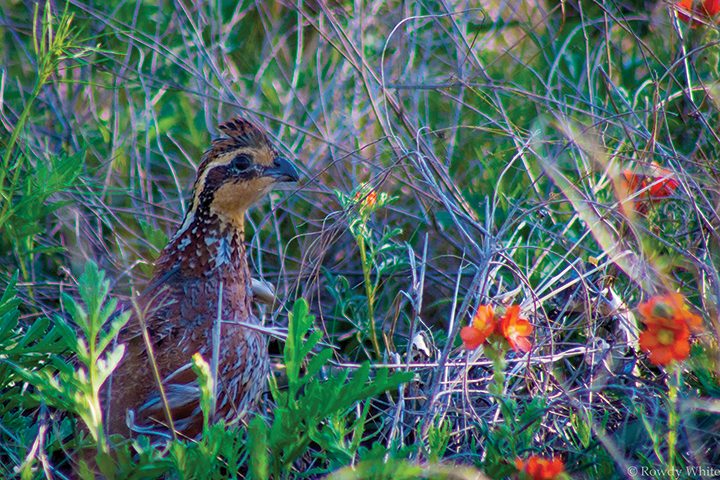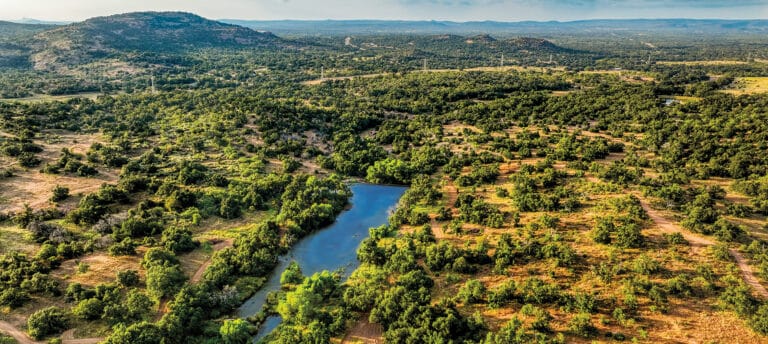
One of the most avid and dedicated group of hunters in the entire state of Texas are those that pursue quail. Often their most cherished possession is one or more good dogs that flush coveys and retrieve birds after they have been shot. Addicted quail hunters will freely spend money to support their habit.
Drs. Dale Rollins, a Texas A&M AgriLife Extension Service wildlife specialist at San Angelo, Jason Johnson, an AgriLife Extension economist at Stephenville and Kelly Reyna with the Department of Biological Science at the University of North Texas in Denton conducted a quail hunter survey in 2000 and again in 2011. Through the latter survey, it was learned that each hunter averaged spending about $8,606 for 8.8 days of quail hunting during the 2010–2011 season. Based on harvest estimates, the expenditures result in $253 per bagged bird.
“The impact that these hunting expenditures have on quail-hunting destination counties and communities is huge,” Johnson said. “The latest survey showed that 46 percent of quail hunting dollars are spent at the hunting destination with another 18 percent going to communities located between the hunter’s home and hunting site. These expenditures are for merchandise, hotels, restaurants, fuel and sales taxes.”
This rosy scenario has a big black cloud over it, however. There is a lack of birds, especially during drought. Decline in bird populations severely threaten the ability of hunters to enjoy their pastime and the continued heightened economy of rural communities. A lot of research dollars, time, and talent are channeled toward solving this problem.
Dr. Brad Dabbert, Burnett Foundation Endowed Professor of Quail Ecology at Texas Tech University, discussed upland game bird production during a recent Sustainable Rangelands Symposium in Lubbock. His presentation was largely based on results from his quail research funded by the Burnett Foundation and the Park Cities Chapter of the Quail Coalition. The remainder of this article contains quotes and information from Dr. Dabbert’s presentation. Although the article focuses on northern bobwhite and scaled quail, much of the information is also applicable to other upland game birds such as lesser prairie chickens and wild turkeys.
[The SURVEY FOUND] Each hunter averaged about $8,606 for 8.8 days of quail hunting during the 2010–2011 season. Based on harvest estimates, the expenditures result in $253 per bagged bird.
Rangelands constitute the largest portion of available land that can serve as quail habitat. The Society for Range Management definition for rangeland is land on which native vegetation is predominantly grasses, grass-like plants, forbs (weeds) or shrubs and is managed as a natural ecosystem. If managed properly, these lands will provide sources of food and cover necessary for quail population growth.
A strategy for sustainable game bird populations is maintenance of sufficient vegetative cover for the species of concern while attempting to minimize negative effects of drought and to maximize positive influences of average and above average precipitation.
Effects of precipitation on population growth
It is important to understand how precipitation influences game bird population growth. Bird life cycles are largely controlled by photoperiod (light and dark cycle). Receptors in the eye and brain detect increasing daylight hours in the spring which triggers hormone release. The hormones cause ovaries and testes to grow. Bird gonads shrink considerably during nonreproductive periods and must go through a multi-week process of regrowth each spring before reproduction can occur. When fully functional, sperm production in males and egg laying by females can begin. In addition, behavioral characteristics associated with reproduction such as incubation and broodiness in females and male whistling begins.
Drought short-circuits the reproductive process. Stress hormones, released because of drought caused factors such as food and water deprivation and heat, override the reproductive system. This causes the gonads to inactivate and shrink. Sperm and eggs are not produced and behaviors associated with reproduction, including whistling, are depressed.
Game bird chicks require 28 percent crude protein for the rapid body and feather growth needed to reach relative adult body size in approximately 15 weeks. Chicks in the wild meet their high protein demand by consuming insects, which average 40 percent crude protein. Insect population growth is suppressed during drought, making them unavailable for chick consumption. Freshly-hatched chicks have a three-day supply of energy and protein they received from the egg yolk. Those that receive inadequate sources of protein die within three weeks of hatch.
Above average precipitation usually leads to significant game bird population growth. Precipitation brings an expansion of suitable habitat and an abundance of food including insects. With abundant food resources hens are able to re-nest if their original nest is depredated. Chick survival is generally high when food resources are abundant because they can meet their protein requirements for rapid growth. The bottom line is game bird population growth is closely linked to precipitation.
Required vegetation height
Regardless of precipitation adequacy, grazing management has a profound effect on upland game birds. Removal of too much biomass by grazing limits ability of vegetation to hide birds and their nests from predators. Vegetation that is too short causes game birds to leave or succumb to depredation. Determine if vegetation is too short by comparing it to the height of the game bird. Average height of a bobwhite is about 10 inches and scaled quail range from 10 to 12 inches tall.
Brush in the habitat can help mitigate deficiency of herbaceous vegetation height if it is in sufficient quantity and far enough apart to allow quail movement through the area. Small, fragmented patches of suitable nesting cover are easily searched by nest predators and can become sinks or death traps that overwhelm the reproductive efforts of upland game birds. Large patches around 150 acres of nesting cover are required to prevent the fragmentation advantage for predators.
For adequate quail survival, Dabbert’s current recommendation is to maintain at least a 16-inch vegetation height. Vegetation in shortgrass dominated plant communities is rarely going to provide the 16-inch stubble height. In these areas, woody plants may need to be used for cover. Mid and tallgrass plant communities will generally provide superior upland game bird cover. For example, little bluestem can usually provide adequate stubble height because a significant portion of the plant is non-grazable. Tall grasses such as indiangrass, big bluestem, and switchgrass are easily managed for adequate stubble height.
Brush and weed management
Brush or woody plant cover is a necessary component of upland game bird habitat. The woody cover composition should be between 10 and 50 percent, depending upon overall management objectives and target plant species. When woody plant cover is excessive, brush reduction can be accomplished with mechanical or herbicide treatments. Remove invasive species such as juniper or mesquite, but leave plants such as agarita, lotebush, skunkbush sumac and hackberry because of their food and cover value to wildlife. Leave brush in mottes, strips, or other patterns that make ecological and logistical sense.
Woody cover provides upland game birds a relatively permanent source of visual obstruction, thermal protection and a source of food. Yuccas are excellent nest sites for scaled quail and juniper provides excellent thermal cover. Dabbert and his research team have monitored quail coveys that spent their entire day under a juniper tree.
In addition to serving as an important food source, weeds provide cover for upland game birds. Weeds usually have a single stalk that rises from the ground for a few inches before branching. This structure provides excellent cover and allows easy chick movement underneath the plant for foraging.
Weed control might be an appropriate practice when weeds dominate a pasture and are shading out grasses; however, it should be done in a manner to leave weed patches or strips throughout the landscape. A deficit of weeds is more easily remedied than a lack of woody cover. Soil disturbance from prescribed fire, disking or high intensity-short term (flash) grazing will produce a crop of weeds.
The most dramatic weed responses after soil disturbance occur after significant fall and winter precipitation. It is not necessary to replant seed mixes, because soil usually holds a bank of weed seeds ready to respond after disturbance. Seeding is usually done if some desired plants are not present. Maintaining weed populations throughout rangeland is one method of sustaining upland game bird populations.
Predator management
There are three steps to predator management, and trapping is the last phase. Habitat management is the first step and if done correctly, provides visual obstruction to hide birds and their nests from predators. Effective habitats are large enough to prevent predators from searching small areas.
The second step is supplemental feeding which allows bobwhites to more quickly gather food and get back to dense protective cover, reducing their exposure to predation. Dabbert and his team have conducted a supplemental feeding study at the 6666 Ranch for the past several years. The supplemental feeding involves broadcasting sorghum grain into quail habitat. Supplemental feeding increased survival of bobwhites from 10 to 50 percent between October and April each year of the study. Reproductive output increased as well.
Improved survival and reproduction have caused bobwhite populations on the 6666 Ranch to greatly outperform the average ranch in the Texas Rolling Plains. This performance is a result of grazing management and cumulative effects of increased winter adult survival and improved reproduction due to the broadcasted feed supplement. Bobwhite populations in the 14,000-acre supplemental feed pasture did not decline as much as on other ranches during the 2011 drought. Because the base population in the supplemental feed pasture was sustained during the drought, the quail were able to more quickly take advantage of the improved rainfall conditions in 2012, 2013 and 2014.
The three-legged stool concept certainly describes management for sustainable quail populations. Three legs in this scenario are habitat, supplemental feeding and lastly, predator control. Trapping may not be necessary for predator control if habitat management and supplemental feeding are properly executed.

